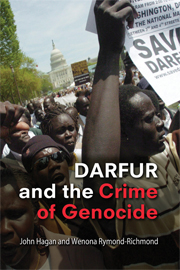Book contents
- Frontmatter
- Contents
- Glossary
- List of Characters
- Prologue: On Our Watch
- Darfur and the Crime of Genocide
- Settlement Cluster Map of Darfur, Sudan
- 1 Darfur Crime Scenes
- 2 The Crime of Crimes
- 3 While Criminology Slept with Heather Schoenfeld
- 4 Flip-Flopping on Darfur with Alberto Palloni and Patricia Parker
- 5 Eyewitnessing Genocide
- 6 The Rolling Genocide
- 7 The Racial Spark
- 8 Global Shadows
- Epilogue: Collective R2P
- Appendix: Genocidal Statistics
- Notes
- Index
- Titles in the series
5 - Eyewitnessing Genocide
Published online by Cambridge University Press: 05 June 2012
- Frontmatter
- Contents
- Glossary
- List of Characters
- Prologue: On Our Watch
- Darfur and the Crime of Genocide
- Settlement Cluster Map of Darfur, Sudan
- 1 Darfur Crime Scenes
- 2 The Crime of Crimes
- 3 While Criminology Slept with Heather Schoenfeld
- 4 Flip-Flopping on Darfur with Alberto Palloni and Patricia Parker
- 5 Eyewitnessing Genocide
- 6 The Rolling Genocide
- 7 The Racial Spark
- 8 Global Shadows
- Epilogue: Collective R2P
- Appendix: Genocidal Statistics
- Notes
- Index
- Titles in the series
Summary
The Prosecutor's Brief
In February 2007, four years after the outbreak of atrocities, the new U.S. Special Envoy to Sudan, Andrew Natsios, corrected the State Department's low mortality estimate and reaffirmed Sudan's genocidal responsibility for hundreds of thousands of deaths in Darfur. “Arming the Janjaweed,” Natsios told the U.S. House Committee on Foreign Affairs, “led to the launching of genocide in 2003 and 2004, which resulted in the deaths of hundreds of thousands of innocent civilians and the destruction of their villages and livelihoods.” Later, on The Nightly Newshour, Natsios confirmed that additional genocidal attacks had occurred within recent months in North Darfur. The interviewer spared Natsios the vexing question of why the United States did not intervene if a genocide was continuing under the watch of President Bush, who had vowed to avoid President Clinton's neglect of Rwanda.
In early 2007, world attention focused instead on the International Criminal Court (ICC) to which the UN Security Council had referred the conflict in 2005. After investigating the two-year-old conflict for an additional two years, the ICC Chief Prosecutor, Luis Moreno-Ocampo, “named names” in February 2007. Moreno-Ocampo, who is both a courageous and calculating prosecutor, identified only two individuals in his February news conference: a Sudanese government minister, Ahmad Muhammad Harun, and an Arab militia leader, Ali Muhammad Abd-Al-Rahman, whose nom de guerre is Ali Kushayb.
- Type
- Chapter
- Information
- Darfur and the Crime of Genocide , pp. 105 - 136Publisher: Cambridge University PressPrint publication year: 2008



